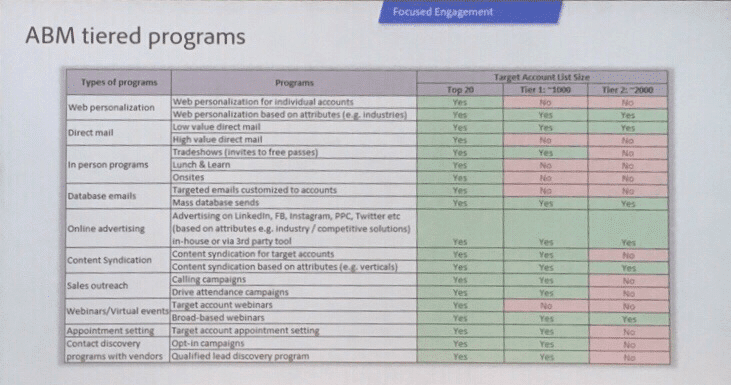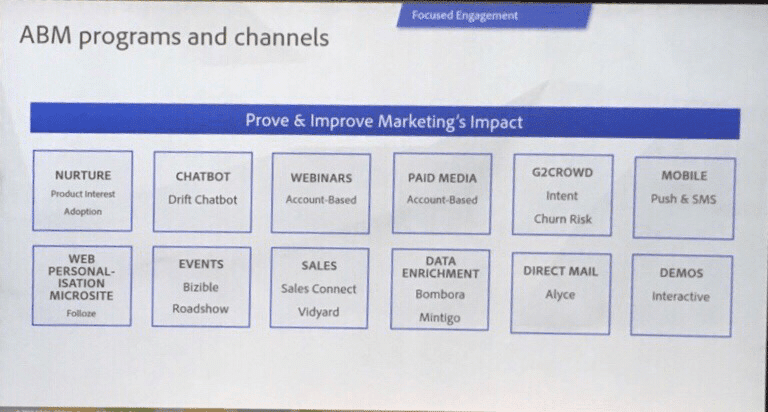This session was one I was really looking forward to attending. Hearing from Marketo about how it runs ABM campaigns. Who better to learn from? Melanie Gipp, a senior marketing manager from Marketo was the speaker who had to try to live up to my high expectations.
Marketo’s recipe for success is plan, engage and measure. In ABM this is translated into shared goals and accounts, focussed engagement and data insights. The session walked us through these three steps, explaining how Marketo builds campaigns using this framework.
Marketo has three key business goals, bookings, deal sizes and win rates. To determine progress in these goals, it uses leading indicators: The pipeline, SQLs, MQLs and AQLs (automated qualified leads). AQLs are a term it developed to indicate that a contact who meets scoring/qualification criteria in the system, but has not had a conversation with sales.
The Marketo customer journey has the following stages:
- The contact makes an inquiry
- The Marketo system determines that they are an automated qualified lead
- The telemarketing team takes the lead, making the contact a telemarketing accepted lead (TAL)
- The lead then goes through conventional MQL and SQL stages
One point that was made very strongly was the need for precise criteria, clear processes and defined responses to ensure good alignment between sales and marketing.
Determining and Tiering Target Accounts
To run an ABM campaign, you obviously need target accounts. When determining how accounts are dealt with in the ABM campaign, they get scored A-D, based on data such as size, product fit, whether they have a competitor solution and whether the account is of strategic importance. Interestingly, using a competitive solution is an indicator that the company is more likely to buy as they have a mature marketing team and are likely to upgrade.
Marketo then looks to see if it has contacts from that company, and whether those contacts are engaged. If there aren’t engaged contacts, outbound research is conducted to understand the account, the internal structure and identify contacts. Where an account is identified as a target and there are already engaged contacts from the organisation, the sales team immediately reaches out to them to begin building relationships and identifying opportunities.
Inbound accounts are also dealt with based on whether they are a target account or not: If the contact is from a target account, they are ranked as high priority leads.
Personalisation and Tactics
There are three levels of accounts addressed in the Marketo ABM campaign: 20 top targets, 1000 tier 1 and around 2000 tier two accounts. Marketo has a matrix that is used to determine what level of personalisation is received by each of the three tiers. The top 20 accounts get everything. For tier 2, Marketo won’t personalise the website to an account, but maybe will personalise the site to an industry, allowing them to address multiple organisations with the same personalisation.
For Marketo’s ABM campaigns, direct mail is a key tactic. It feels this is both simpler than email when you are looking at the issues surrounding privacy and consent; and is more effective, particularly when trying to reach senior, C-level contacts. Not only do they often not read all their emails, Marketo believes that executives are rarely reached through conventional inbound programmes: They don’t tend to sit at the desk and search ‘how do I improve sales alignment?’ By sending truly personalised direct mail pieces they have had good results and use Alyce to automate this process.
Marketo produces great content, so promoting and re-purposing this content is a key element of their ABM activities. In particular, it finds having content that is targetted at specific personas allows it to reach all the members of the DMU. One interesting tactic is it has taken blog articles and repackaged into a magazine: ‘Fast CMO’. Melanie told us that they have seen ‘amazing results’ from this activity.
Other Funnel Stages
The ABM campaigns don’t just include top of the funnel activities, it also uses events and paid media to reach people in the middle of the funnel with different tactics to drive greater engagement.
Existing customers are addressed by Marketo’s ABM campaigns, particularly with cross-sell campaigns to increase the range of products used. With the tighter integration of Marketo with the other Adobe marketing tools, it’s likely this will only increase in the future.
Marketo use a ‘multitude of different channels’ in its ABM campaigns, which are illustrated by the slide below. Much of the activity is designed to drive greater personalisation – for example the nurture email sequence aims to drive contacts to a microsite which has very specific personalisation for that individual. Again, Melanie highlighted the rationale of running ABM is to give the company an opportunity to create very personalised engagement.
Data, Data, Data
Data is obviously an important part of ABM campaigns, and here Marketo relies on a large number of partners, such as G2 Crowd to provide intent data, Mintigo to deliver account demographics and Drift for personalised chat. Marketo unsurprisingly pointed to the importance of Bizible for multi-touch attribution (Bizibile is owned by Marketo).
Data was a key theme of the Adobe Summit this year, but you can have too much data. Melanie made a great point about measuring different things at different times: By using the right data at the right time, you get great insights without data overload. The key metrics measured by Marketo for their ABM campaigns are:
Early Stage
- New contacts
- New target contacts
- Opt-ins
Mid Stage
- Call connects
- Meetings
- MQLs
Late Stage
- Opportunities
- Pipeline/ARR
- Revenue won
Marketo’s ABM Take-Aways
As one of the best presentations of the event, it’s hard to summarise all the great information into a few key take-aways. Melanie offered three key things to remember:
- Agreeing shared goals and accounts with sales
- Focussed company wide engagement
- Data and insights both at the lead and company level
What to find out more about ABM and what it can do for you? Check out our ABM page for more information.


